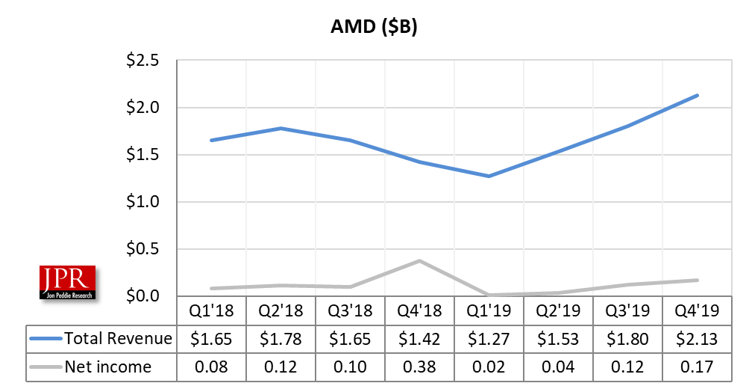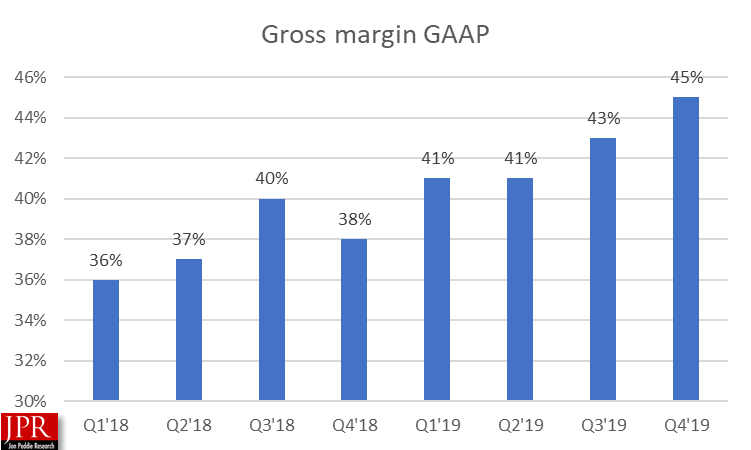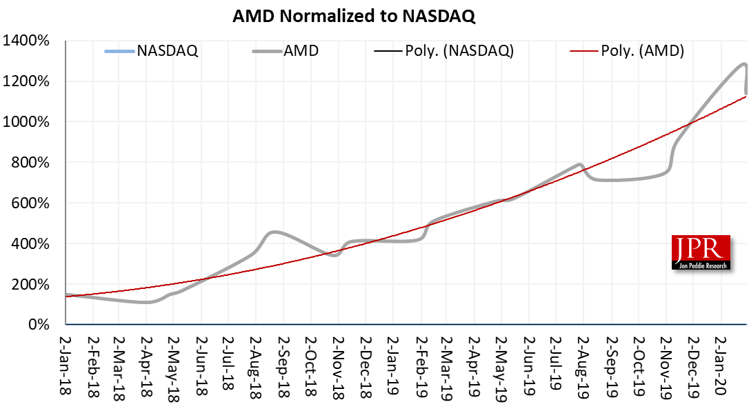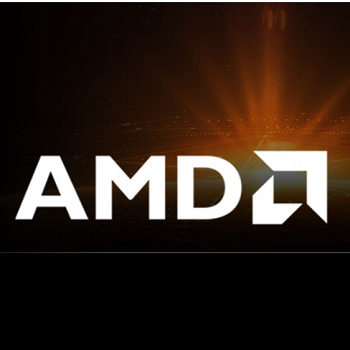Revenue for the quarter was up 18% from last quarter to $2.1 billion, GAAP profit was $170 million, 42% up from last quarter.

Despite a great quarter, AMD’s stock was down about 2.6% after the company reported its Q4’19 which beats Wall Street estimates. The problem was the company’s guidance for Q1’20 was slightly below what Wall Street anticipated.
The company announced revenue for Q4’19 of $2.13 billion, operating income of $348 million, net income of $170 million. On a non-GAAP basis, operating income was $405 million.
For the fiscal year 2019, the company reported revenue of $6.73 billion, operating income of $631 million, net income of $341 million.
“2019 marked a significant milestone in our multi-year journey as we successfully launched and ramped the strongest product portfolio in our 50-year history,” said Dr. Lisa Su, AMD president and CEO. “We delivered significant margin expansion and increased profitability as we gained market share with our Ryzen and EPYC processors. Our focused execution and the investments we made in our high-performance computing roadmaps position us well for continued growth in 2020 and beyond.”
Quarterly revenue of $2.13 billion was up 50% year-over-year primarily driven by the Computing and Graphics segment. Revenue was up 18% compared to the prior quarter as a result of higher revenue in the Computing and Graphics segment partially offset by lower revenue in the Enterprise, Embedded, and Semi-Custom segment.
Gross margin was 45% compared to 38% a year ago and 43% in the prior quarter. Non-GAAP gross margin was 45% compared to 41% a year ago and 43% in the prior quarter. Gross margin improvements were primarily driven by the ramp of 7-nm products.

The company’s 2019 annual revenue of $6.73 billion was up 4% year-over-year driven by higher revenue in the Computing and Graphics segment partially offset by lower revenue in the Enterprise, Embedded, and Semi-Custom segment.
Gross margin was 43% compared to 38% in the prior year. Gross margin expansion was primarily driven by Ryzen and EPYC products.
Graphics group
Computing and Graphics segment revenue was $1.66 billion, up 69% year-over-year and 30% compared to the prior quarter driven primarily by strong sales of Ryzen processors and Radeon gaming GPUs.
Operating income was $360 million compared to $115 million a year ago and $179 million in the prior quarter. Operating income improvements were primarily driven by higher revenue from Ryzen processor sales.
Client processor average selling price (ASP) was up year-over-year and sequentially driven by Ryzen processor sales.

GPU ASP was up year-over-year and sequentially primarily driven by higher channel sales.
AMD announced the new 4000 Series 8 core mobile processors based on the 7-nm Zen 2 architecture with Radeon graphics for upcoming ultrathin, gaming and mainstream laptops from Acer, Asus, Dell, HP, Lenovo, and other OEMs. The first Ryzen 4000 Series and Athlon 3000 Series powered laptops are expected to be available starting in Q1 2020, with more than 100 systems expected to launch throughout 2020.
The company also introduced its most powerful desktop processors, the 3rd Gen AMD Ryzen Threadripper family, including the 24-core AMD Ryzen Threadripper 3960X, 32-core AMD Ryzen Threadripper 3970X and 64-core desktop processor, the AMD Ryzen Threadripper 3990X.
AMD expanded its gaming and professional graphics card offerings and unveiled the Radeon RX 5600 Series for ultimate 1080p gaming, including the Radeon RX 5600 XT, the Radeon RX 5600 and the Radeon RX 5600M for laptop PCs. The company said the Radeon RX 5600 Series offers up to 20% faster performance on average across select AAA games compared to competitive offerings.
The company also introduced the Radeon RX 5500 XT graphics card. Built on its RDNA architecture and 7-nm process technology, the AMD Radeon RX 5500 XT, said the company, provides up to 13% faster performance on average in today’s top AAA games than the competition.
AMD has been steadily improving its gross margin.

Apple announced the latest Apple MacBook Pro, which features the new Radeon Pro 5500M and 5300M mobile GPUs.
And AMD launched a 7-nm professional PC workstation AIB for 3D designers, architects, and engineers, the AMD Radeon Pro W5700 graphics card. The AIB is a configuration option in the latest Apple Mac Pro, alongside the AMD Radeon Pro Vega II and AMD Radeon Pro 580X GPUs.
Outlook
For the first quarter of 2020, AMD expects revenue to be approximately $1.8 billion, plus or minus $50 million, an increase of approximately 42% year-over-year and a decrease of approximately 15% sequentially. The year-over-year increase is expected to be driven by the strong growth of Ryzen, EPYC, and Radeon product sales. The sequential decrease is driven primarily by negligible semi-custom revenue which continues to soften in advance of the ramp of next-generation products, in addition to seasonality. AMD expects non-GAAP gross margin to be approximately 46% in the first quarter of 2020.
For the full year 2020, AMD expects revenue growth of approximately 28–30% over 2019 driven by strength across all businesses. AMD expects non-GAAP gross margin to be approximately 45% for 2020.
Though the quarterly outlook disappointed some investors, AMD’s revenue growth forecast reflects a strong demand for server chips from cloud data center operators and personal computer makers, mirroring Intel’s report from last week.
“We delivered significant margin expansion and increased profitability as we gained market share with our Ryzen and EPYC processors,” Chief Executive Officer Lisa Su said in the statement. “Our focused execution and the investments we made in our high-performance computing roadmaps position us well for continued growth in 2020 and beyond.”
What do we think?
Although AMD reported record quarter and year results, Wall Street, which is supposed to be so good at predicting a company’s results, reacted negatively to AMD’s announcement that its semi-custom sales would be down as Microsoft and Sony plan for their next console launches in Q4; evidently Wall Street didn’t expect that.
The day after AMD’s announcement, tech stocks took a dive, even though NASDAQ and Dow were up. The selloff was driven by fears about supply chain disruption due to the Coronavirus outbreak in China.

Regardless of the machinations of the Wall Street sharpshooters, which only affects top management stock options, the company is doing great and is on a path to continue doing great with award-winning architectures in GPUs and CPUs, and a string of design wins—including game console for which the sharpies are punishing AMD.
What Wall Street should be looking at is not one quarter’s softness in Semi-Custom, but the impact of Intel entering the dGPU market. That’s a bigger worry for AMD and Nvidia.






